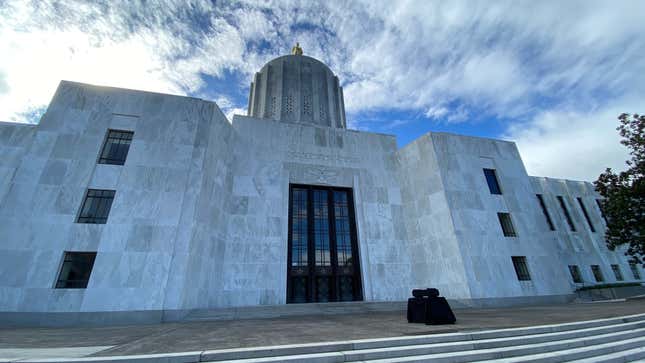
Twelve years ago, I strode by Clark Glacier on the flanks of South Sister, the tallest of a cluster of three volcanoes in Oregon’s Cascades. The mass of ice clung to the slopes, strewn with red and brown streaks left behind by volcanic cinders that tumbled across its face.
The glacier was unremarkable compared to neighboring Lewis Glacier, which hung in a dramatic cirque above a glacial lake. But I probably should’ve given Clark Glacier more attention at the time. Though I didn’t realize it at the time, the views of that hike are gone forever. On Sunday, the watery remains taken from Clark Glacier were wrapped in a black funeral shroud and laid out front of the Oregon Capitol. The glacier is officially dead, and mourners in Salem and on South Sister recalled the glacier and memories of other ice lost to the climate crisis.
The funeral held for Clark Glacier took inspiration from a funeral held for dead ice in Switzerland and Iceland last year and is part of a growing sense of grief for the collapse of the natural world at the hands of unfettered capitalism.
“We should do a public mourning because a part of our Earth is gone, it is our fault, and it won’t come back unless we fundamentally change our thoughts on nature and how we live with and in it,” Anders Carlson, the president and chief scientist of the recently formed Oregon Glaciers Institute who presided over the funeral at the Capitol, said in an email.
The institute is focused on cataloging the health of Oregon’s glaciers. There are estimated to have been around 50 glaciers across state’s high peaks at the start of the Industrial Revolution. But rising temperatures have wrought havoc on them as well as glaciers across the world. Despite that, Carlson said, it’s been 70 years since there has been a full accounting of Oregon glaciers’ health.
In Clark Glacier’s case, the group has pronounced it dead. Glaciers are defined by their movement, slowly grinding down mountains under the mass of ice. While a permanent patch of snow and ice may remain, it’s stationary. The metaphor comparing the glacier’s remnants to a dead body writes itself and extends to what it gave in life and what its mourners lost in death.

“That glacier sustained our way of life here in Oregon,” Carlson said. “It fed streams that irrigated crops, watered cattle, and cooled the forests to reduce the fires that rage. While Oregon’s fires were the worst on record this year, they would only have been worse if it wasn’t for the few remaining glaciers in the headwaters of the valleys that burned. We took from the glacier and now it is gone.”
The public mourning follows a similar ceremony in Iceland last August, where Okjökull Glacier has also degraded into a patch of snow. There, mourners installed a plaque noting it was “the first Icelandic glacier to lose its status as a glacier. In the next 200 years all our glaciers are expected to follow the same path. This monument is to acknowledge that we know what is happening and know what needs to be done. Only you know if we did it.”
Swiss mourners followed suit in September last year, turning out for Pizol Glacier. Extinction Rebellion has also frequently invoked the death of the natural world and mourning in its protests. The increasingly public displays of climate grief show how people are focusing on specific, concrete symbols of more widespread loss of the biosphere that has sustained humanity and allowed civilization to flourish. There’s even a word for it: solastalgia.
“The climate emergency brings forward all of this grief, as well as terror, rage, guilt, shame, all these all these feelings,” Margaret Klein Salamon, a psychologist who founded the Climate Mobilization, said. “But but grief is a very important one. And so we’re dealing with all of this, but we’re mourning it alone largely. What a funeral, a display like this does is that it makes that public and shared. That can help people feel less alone and supported in their loss. By mourning a loss, it is a way to move on and live in reality as opposed to the past”
She said it has to go further than just mourning the death of individual glaciers, species, or even ecosystems. This is about a planetary decline and focusing on one loss alone distracts from the society-rending changes that are afoot if carbon pollution isn’t rapidly drawn down. Any mourning without placing it in the larger context guarantees many more funerals in the future, including for people who lose their lives to climate change-fueled disasters.
“What we’ve lost is the tiniest beginning of the absolute catastrophe we are accelerating toward,” Klein Salamon said.